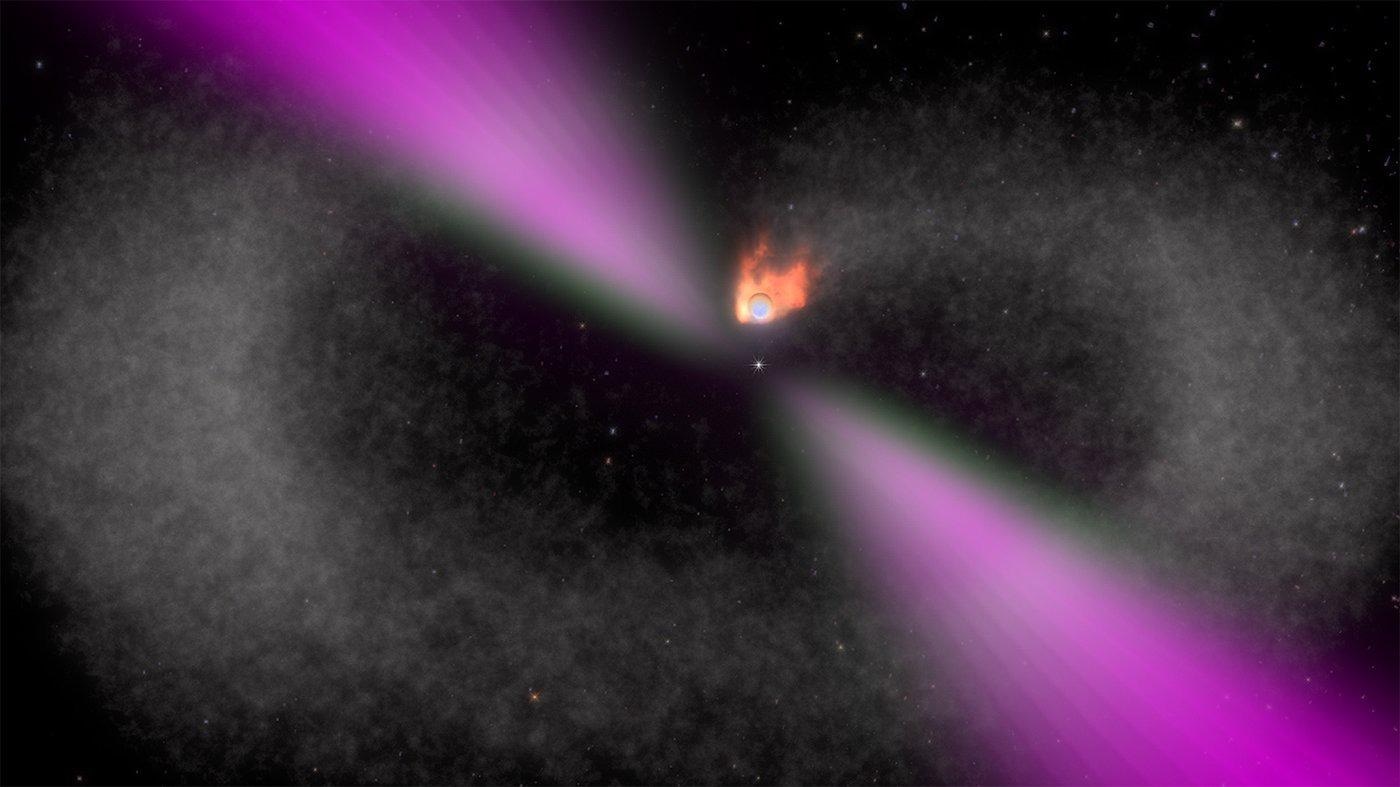A fast spinning dead star known as a pulsar attacks its orbiting partner with radiation, gradually evaporating it in black widow star systems. The pulsars, like their namesake spiders, reap the benefits of their lower-mass companion stars before destroying them by harvesting material and energy from them.
 An illustrated view of a black widow pulsar and its stellar companion. The pulsar’s gamma-ray emissions (magenta) strongly heat the facing side of the star (orange). The pulsar is gradually evaporating its partner. Image Credit: NASA’s Goddard Space Flight Center/Cruz deWilde.
An illustrated view of a black widow pulsar and its stellar companion. The pulsar’s gamma-ray emissions (magenta) strongly heat the facing side of the star (orange). The pulsar is gradually evaporating its partner. Image Credit: NASA’s Goddard Space Flight Center/Cruz deWilde.
A recent study published in Nature describes a new possible black widow star system called ZTF J1406+1222, in which the stars orbit each other every 62 minutes, the lowest orbital period for this sort of binary star system ever detected. PSR J1653-0158, the former black widow record holder, has stars circling around each other every 75 minutes.
The Zwicky Transient Facility (ZTF) instrument at Caltech’s Palomar Observatory near San Diego was used to discover the new candidate system. The National Science Foundation (NSF) and an international consortium of partners support the ZTF.
“This 62-minute orbit is remarkable because we don’t understand how the stars could get into such a tight orbit,” states Kevin Burdge (PhD ‘21), an MIT postdoctoral fellow who conducted the research at Caltech. “The process of the pulsar ablating its companion should actually drive them apart. This is pushing the boundaries of what we thought possible.”
Future measurements from NASA’s Chandra X-Ray Observatory, according to Burdge, should help validate the result.
Our data indicate we are looking at a black widow binary, but it could be something entirely new.
Kevin Burdge, Postdoctoral Fellow, Massachusetts Institute of Technology
The first black widow star was detected in the 1980s, and ever since then, a few dozen more have been identified, along with a spidery “species” of stars known as redbacks, which includes pulsars and fatal partners. According to scientists, pulsar stars in both the redback and black widow systems gain energy and speed by siphoning material away from their neighbors.
The lower-mass stars donate material to their partner stars but suffer the consequences.
Kevin Burdge, Postdoctoral Fellow, Massachusetts Institute of Technology
The novel candidate black widow binary stars were discovered by examining millions of stars in the night sky for those that flash on and off fast. Thanks to its camera’s enormous field of view, which covers an area of sky similar to a grid of 247 full moons, ZTF records photographs of the entire night sky every two nights. Scientists can use the sky survey to look for objects that modify brightness or location on short timescales.
ZTF has revealed a zoo of exotic stellar species. Rather than being boring, static objects, a large fraction of stars exhibit dips, pulsations, or periodic brightenings that are a key to understanding their nature.
Tom Prince, Study Co-Author and Ira S. Bowen Professor of Physics, Emeritus, Caltech
Prince was also a co-investigator of ZTF.
Burdge used an algorithm to look for ZTF objects that change brightness drastically over durations of less than 80 minutes in this circumstance.
Researchers discovered ZTF J1406+1222, a star whose brightness changes by a factor of 13 every 62 minutes. The pulsar’s companion, a cold failed star known as a brown dwarf, revolving on its axis, produces the system’s cyclical fading and brightening.
The brown dwarf being bombarded by the pulsar retains heat on one side while remaining cooler on the other. Telescopes cannot distinguish the pulsar and the brown dwarf, but as the brown dwarf’s hot side rotates into view from Earth, the total brightness of the system increases; contrarily, when the cool side swings around, the brightness decreases.
Surprisingly, this black widow system contains a third partner orbiting at a far greater distance, about 600 astronomical units, or AUs (an AU is the distance between Earth and the sun). The third partner star orbits the close pair every 10,000 years, whereas the primary pulsar and brown dwarf orbit each other every 62 minutes.
The researchers also highlight that this is the first time optical light has been used to find a black widow system. “The population of black widows we’ve been finding so far with other wavelengths of light, such as X-rays, gamma rays, and radio waves, is probably biased because we haven’t been catching all of them,” says Burdge. “Now we have a new lens through which we can identify these systems.”
The results were observed using data from the W. M. Keck Observatory on Maunakea in Hawaii, the Grand Canary Telescope in the Canary Islands, Spain, the European Space Agency’s Gaia space observatory, and the Sloan Digital Sky Survey.
The NSF, NASA, and the MIT Pappalardo Fellowships program all contributed to the study’s completion.
'Black Widow' Pulsar Animation
This animation from NASA's Goddard Space Flight Center, which depicts a different black widow system, illustrates how a pulsar evaporates its companion over time. Video Credit: NASA's Goddard Space Flight Center/Cruz deWilde.
Journal Reference:
Burdge, K. B., et al. (2022) A 62-minute orbital period black widow binary in a wide hierarchical triple. Nature. doi.org/10.1038/s41586-022-04551-1.